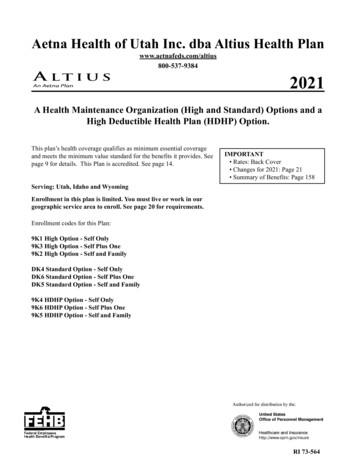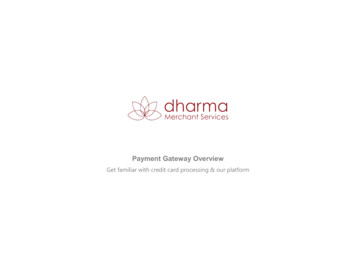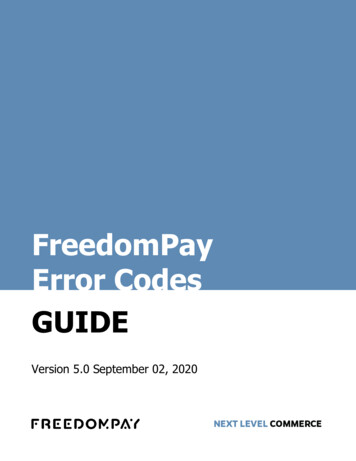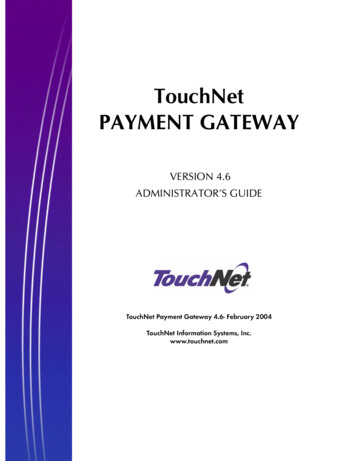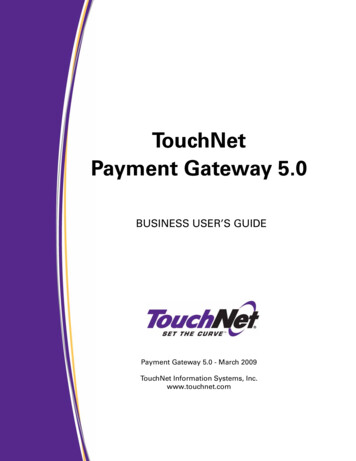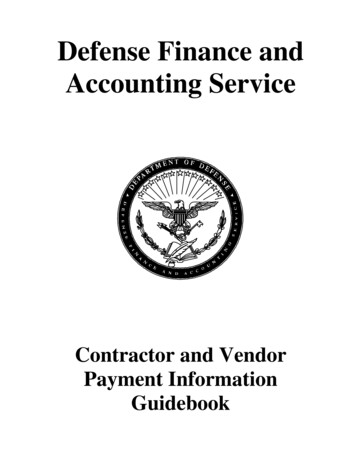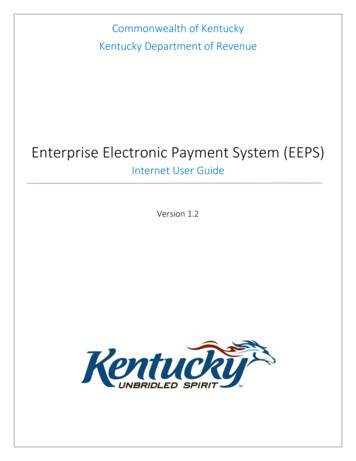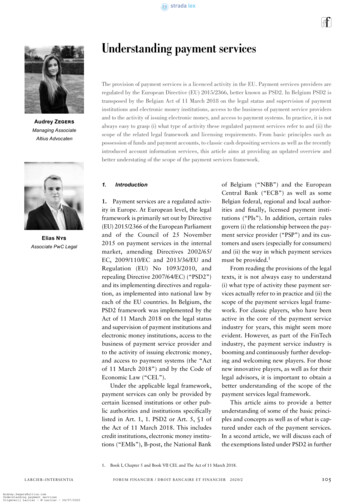
Transcription
Understanding payment servicesAudrey ZegersManaging AssociateAltius AdvocatenThe provision of payment services is a licenced activity in the EU. Payment services providers areregulated by the European Directive (EU) 2015/2366, better known as PSD2. In Belgium PSD2 istransposed by the Belgian Act of 11 March 2018 on the legal status and supervision of paymentinstitutions and electronic money institutions, access to the business of payment service providersand to the activity of issuing electronic money, and access to payment systems. In practice, it is notalways easy to grasp (i) what type of activity these regulated payment services refer to and (ii) thescope of the related legal framework and licensing requirements. From basic principles such aspossession of funds and payment accounts, to classic cash depositing services as well as the recentlyintroduced account information services, this article aims at providing an updated overview andbetter understating of the scope of the payment services framework.1.Elias NysAssociate PwC Legal1. Payment services are a regulated activity in Europe. At European level, the legalframework is primarily set out by Directive(EU) 2015/2366 of the European Parliamentand of the Council of 25 November2015 on payment services in the internalmarket, amending Directives 2002/65/EC, 2009/110/EC and 2013/36/EU andRegulation (EU) No 1093/2010, andrepealing Directive 2007/64/EC) (“PSD2”)and its implementing directives and regulation, as implemented into national law byeach of the EU countries. In Belgium, thePSD2 framework was implemented by theAct of 11 March 2018 on the legal statusand supervision of payment institutions andelectronic money institutions, access to thebusiness of payment service provider andto the activity of issuing electronic money,and access to payment systems (the “Actof 11 March 2018”) and by the Code ofEconomic Law (“CEL”).Under the applicable legal framework,payment services can only be provided bycertain licensed institutions or other public authorities and institutions specificallylisted in Art. 1, 1. PSD2 or Art. 5, §1 ofthe Act of 11 March 2018. This includescredit institutions, electronic money institutions (“EMIs”), B-post, the National Bank1.L A R C I ER –INT E R SE NT IAAudrey.Zegers@altius.comUnderstanding payment servicesUitgeverij Larcier - Larcier - 24/07/2020Introductionof Belgium (“NBB”) and the EuropeanCentral Bank (“ECB”) as well as someBelgian federal, regional and local authorities and finally, licensed payment institutions (“PIs”). In addition, certain rulesgovern (i) the relationship between the payment service provider (“PSP”) and its customers and users (especially for consumers)and (ii) the way in which payment servicesmust be provided.1From reading the provisions of the legaltexts, it is not always easy to understand(i) what type of activity these payment services actually refer to in practice and (ii) thescope of the payment services legal framework. For classic players, who have beenactive in the core of the payment serviceindustry for years, this might seem moreevident. However, as part of the FinTechindustry, the payment service industry isbooming and continuously further developing and welcoming new players. For thosenew innovative players, as well as for theirlegal advisors, it is important to obtain abetter understanding of the scope of thepayment services legal framework.This article aims to provide a betterunderstanding of some of the basic principles and concepts as well as of what is captured under each of the payment services.In a second article, we will discuss each ofthe exemptions listed under PSD2 in furtherBook I, Chapter 5 and Book VII CEL and The Act of 11 March 2018.FO RUM FI N AN CI ER / DR O IT B AN C AIR E E T F IN AN C IE R2020/2105
Understanding payment services Audrey Zegers & Elias Nysdetail. It goes without saying that a lot more is to be saidabout the PSD2 framework. For example, in this article wedo not cover any issues about the territorial scope of PSD2.We also do not go into the details of the PSD2 inspiredpayment user and consumer protection rules, e.g. the rulesimposing information obligations on PSPs, or setting outthe payment user’s rights and obligations related to the useof payment services.2offering only those services are subject to less burdensomeregulatory requirements compared to PSPs offering services1 to 6. For example, they have almost no or much less strictown fund requirements, as opposed to other PSPs.7Although the possession of funds can no longer be usedas the general key criterion for the application of PSD2, inour view it remains an important element or characteristicwhen assessing whether a service or an activity could fallwithin the scope of any of the payment services 1 to 6.2.2.2. Payment service userBasic principles and concepts proper to allpayment service activities2.1. Possession of funds as key element2. Although not explicitly mentioned in the legal texts, akey element in determining the scope of application of thepayment services legal framework has always been the possession of client funds by the PSP. This rationale certainlymade sense under PSD1, which only regulated 6 types ofpayment services for which the PSP indeed, at one time oranother, entered into the possession of client funds.3Even though PSD1 failed to explicitly provide for sucha criterion, it could be derived from the exemption fortechnical service providers, who were exempted if they didnot enter into possession of the funds.4 According to thestudy of London Economics on the application of PSD1,the decisive role of the funds’ possession may be assumedin light of the PSD1’s goals which include securing consumers against the provider’s default. Where the provider doesnot enter into the possession of funds, the risk of defaultis not present”.5The question now arises as to whether this implicit criterion can still be used to determine the application of thePSD2 regime. PSD2 introduced two new types of paymentservices – payment initiation and account information –that are characterised by the fact that the PSP does not comeinto possession of the client funds.6 For that reason, PSPs3. The payment service user (“PSU”) is an important PSDconcept, as the payment service legal framework aims atprotecting the user in its relation towards a PSP.8 A PSUis any natural or legal person making use of a paymentservice in the capacity of payer, payee, or both.9 The payercan be any natural or legal person who holds a paymentaccount and allows a payment order from that paymentaccount. Where no use is made of a payment account, thepayer can be any person who gives a payment order.10 Thepayee is any natural or legal person who is the intendedrecipient of funds which have been the subject of a payment transaction, such as the beneficiary of a direct debitor an online merchant accepting card payments.11As a rule, the payer is the person whose paymentaccount is debited as a result of a payment transaction.The payee is the person whose payment account is credited.12 However in some cases, such as money remittance,no payment account might be credited and/or debited asno payment account might be involved in the transaction(see paragraph 25 below).It is interesting to note that the definition of PSU onlyrefers to the notions of payer and payee. However, in caseof account information services, no actual payer or payeecan be identified, as this service does not entail the execution of a payment transaction or transfer of funds. For thepurpose of account information services, the PSU is theFor more information on these topics we refer to for example J. SAD, “Les services de paiement”, in Traité pratique de droit commercial – Tome 5: droit bancaire etfinancier, Waterloo, Kluwer, 2016, 229–338 (hereafter J. SAD, “Les services de paiement”).3. Directive 2007/64/EC of the European Parliament and of the Council of 13 November 2007 on payment services in the internal market amending Directives 97/7/EC,2002/65/EC, 2005/60/EC and 2006/48/EC and repealing Directive 97/5/EC (“PSD1”).4. Art. 3, (J) PSD1; Art. 4, 10 of the Act of 10 December 2009.5. IFF, London Economics and PaySys, Study on the impact of Directive 2007/64/EC on payment services in the Internal Market and on the application of Regulation(EC) No. 924/2009 on cross-border payments in the community, February 2013, 107 (hereafter: IFF, London Economics and PaySys, Study on the impact of PSD).6. Recital 35 PSD2.7. Art. 17 & 33 of the Act of 11 March 2018; Art. 7 & 8 PSD2; PSPs only offering payment initiation services should have an initial capital of EUR 50,000 and theirown funds shall not fall below the amount of the initial capital. PSPs offering account information services do not have any initial capital or own funds requirements tocomply with. Nevertheless, they remain subject to important other organisational and financial requirements, such as the requirement to have an appropriate liabilityinsurance in place.8. R. Steennot, “Art. 1 – 81 Artikelsgewijze Commentaar Wet betalingsdiensten” in X, Financieel recht. Artikelsgewijze commentaar met overzicht van rechtspraak enrechtsleer, Kluwer, 23.9. Art. 4, (10) PSD2; Art. 2, 19 of the Act of 11 March 2018.10. Art. 4, (8) PSD2; Art. 2, 20 of the Act of 11 March 2018.11. Art. 4, (9) PSD2; Art. 2, 21 of the Act of 11 March 2018.12. R. Steennot, “Art. 1 – 81 Artikelsgewijze Commentaar Wet betalingsdiensten” in X, Financieel recht. Artikelsgewijze commentaar met overzicht van rechtspraak enrechtsleer, Kluwer, 24.2.106Audrey.Zegers@altius.comUnderstanding payment servicesUitgeverij Larcier - Larcier - 24/07/2020FI N AN CI EEL FO RU M / B AN K - E N F IN AN C IE E L R E C HT2020/2L AR C IE R – IN T ER S ENT I A
Audrey Zegers & Elias Nys Understanding payment servicesperson who holds the payment account from which theinformation is being provided.2.3. Regular occupation or business activitypayment services16 in connection with or in the contextof this activity is unlikely to fall within the scope of application of the payment services framework. The paymentservices should constitute a substantial part of the activityand profit of the company.2.3.1. General2.3.3. Complementary character4. Another key principle that might not immediately beclear from reading PSD2 or the Act of 11 March 2018is that the payment services legal framework is limitedto service providers who provide payment services as a“regular” occupation or business activity.13 This meansthat other types of market players may, in principle, offerpayment services outside the legal framework as long astheir payment services cannot be designated as being theirregular occupation or business activity.The payment services legislation does not provide anyspecific criteria to determine whether or not a paymentservice can be characterised as the “regular” occupationor business activity of a company. In practice, it is up tothe NBB and the Belgian courts14 to decide. However, agood test in this context is the application of two specificconditions (to be met simultaneously) developed by existing legal doctrine case law. For the application of the legalframework to be excluded:(i) the payment services may not be the main activity ofthe undertaking; and(ii) the payment services must be complementary to theother activities of the undertaking.156. However, it is also necessary to consider the finalityof the main activity of the company and the complementary nature of the payment services. If a payment service isoffered separately and in addition to the main activity, thecompany will, in principle, be subject to a licence requirement as payment institution, regardless of the size of thisactivity. For instance, a company that mainly produces andsells goods and also offers money remittance services (seeparagraph 25) will, in principle, have to obtain a licencefor such services, as these services are in no way complementary and necessary to supplement the main activity,being the production of goods.17 Needless to say, this isonly so if no other exemptions apply.2.3.4. Other criteria7. Other, quantitative, criteria that may be taken intoaccount by regulators are: (i) the proportion (percentage)of the profit from payment services in the overall profitof the company, (ii) the fact that the payment services areadvertised/marketed as such and/or (iii) the possible intervention/use of a third-party/licensed payment institution.182.3.2. Main activity2.3.5. Impact5. First of all, the main or principal activity of thecompany should be taken into account. A company thatproduces goods or offers services and in addition offers8. Without the notion and principle of regular occupation or business activity, the payment services legislation13. Recital 24 PSD2; See also recital 6 PSD1 and confirmed by the European Commission (“EC”) in its questions and answers on PSD1 (“Q&A”) clarifying that this recitalshould be read in conjunction with Art. 1(2) PSD1 (Note that the same article still exists under PSD2); EC, your questions on PSD, question 125, https://www.trivvy.nl/uploads/5/1/6/0/51608851/faq en.pdf.It is also interesting to note that the Act of 11 March 2018 does not refer to the concept of regular occupation or business activity. Nevertheless, we take the viewthat the same principle applies in Belgium and that a licence is only required for service providers having payment services as one of their main activities. This waspreviously confirmed by the CBFA (Banking, Finance and Insurance Commission, now NBB) in its annual report of 2009–2010. (CBFA, Verslag DC 2009–2010, 45).In addition, as far as the application of the applicability of the rules on the contractual relationship between PSPs and the users as well as the consumer protectionrules are concerned, the CEL contains provisions that indirectly confirm this principle: Art. I.9.1 CEL defines “payment service” as every service offered for sale in thecourse of a business activity. Art. I.9.2 CEL provides for a definition of PSP that is identical to the one previously used in the Act of 21 December 2009 on the legalstatus of payment institutions and electronic money institutions, access to the business of payment service provider and to the activity of issuing electronic money and access topayment systems (“Act of 21 December 2009”). In the preparatory works of this Act, it is explained that the definition of PSP should be limited to PSPs or contractualservice providers whose principal activity is the provision of payment services; Parl. Doc. 2008–09, no. 2182/001, 13.In addition, Art. I.9.2 CEL states that “A person who, as a regular occupation or business (activity), provides payment services to payment service users or electronicmoney to a holder of electronic money without the necessary licence or authorisation nevertheless remains subject to the mandatory provisions of this Act”. A contrario, it can be derived from the same text that a person who does not carry out such activities as a regular occupation or business activity is not subject to this legalframework; P. E. Berger & S. Landuyt, “Toepassingsgebied van de Wet Betalingsdiensten en de Wet betalingsinstellingen” in Instituut Financieel Recht (ed.), Financiëleregulering in de kering, Antwerp-Cambridge, Intersentia, 2012, 138 (hereafter: P. E. Berger & S. Landuyt, “Toepassingsgebied van de Wet Betalingsdiensten en deWet betalingsinstellingen”).14. As far as the application of the rules included in the CEL is concerned.15. In the preparatory works of the Act of 21 December 2009, it is also stated, when discussing the characteristics of the concept of payment service, that the paymentservice is the principal element of the service offered. Payment services that are ancillary to the supply of goods or services are, in principle, out of scope; Parl. Doc.2008–09, no. 2182/001, 13; P. E. Berger & S. Landuyt, “Toepassingsgebied van de Wet Betalingsdiensten en de Wet betalingsinstellingen”, 139.16. For example, a company that sells goods and maintains remunerated accounts for its customers in this context.17. P. E. Berger & S. Landuyt, “Toepassingsgebied van de Wet Betalingsdiensten en de Wet betalingsinstellingen”, 137.18. P. E. Berger & S. Landuyt, “Toepassingsgebied van de Wet Betalingsdiensten en de Wet betalingsinstellingen”, 138.L A R C I ER –INT E R SE NT IAAudrey.Zegers@altius.comUnderstanding payment servicesUitgeverij Larcier - Larcier - 24/07/2020FO RUM FI N AN CI ER / DR O IT B AN C AIR E E T F IN AN C IE R2020/2107
Understanding payment services Audrey Zegers & Elias Nyswould capture activities and businesses that should clearlynot be subject to such strict licensing and other obligations.Even though the payment services legislation already lists anumber of activities that are specifically exempted from itsscope19, there are many other possible scenarios or activities that are not included in this list. These latter activitiescould, under a broad interpretation of the law, fall withinthe scope of one or another payment service.Let us take the example of funds received by lawyers,tax representatives, bailiffs or notaries. It seems evidentand appropriate that a notary or lawyer should not berequired to obtain a license as a payment institution simply because he receives funds in his third-party accounton behalf of his clients and further transfers such fundsto an account indicated by his client (i.e. an account heldin the name of his client or another beneficiary). Under astrict interpretation, such a transaction could fall withinthe scope of service 3 (execution of payment transactions).However, in this case, the transfer of funds is clearly notthe main service provided to the client. Moreover, in principle, no remuneration is paid specifically in relation to thetransfer of the funds either. The purpose and main activityof the professions of lawyer or notary concern the provision of legal services, not payment services.20The principle of regular occupation also helps to allowfor the development of other innovative services bothwithin the financial (FinTech) sector and in other sectorssuch as market players developing payment collectionservices.An example could be a platform on which, or an intermediary via whom, invoices are sold. The platform facilitates the sale/purchase of the invoices but also offers debtcollection services. It follows up on the payment of theinvoices (and chases debtors where necessary), collectspayments from debtors, and transfers the amounts to thebuyer/owner of the invoice. Depending on the businessmodel, clients of the platform (buyers and sellers) maypay a general membership fee, and/or also an amount perinvoice sold. As this is not customary, we assume that noseparate fee is charged for every payment of (part of) theinvoice that is collected and transferred. In so far as suchservices cannot already make use of the general exemptionfor commercial agents under Annex I.B, 2 of the Act of11 March 2018 (e.g. for the invoice sale/purchase services),it is generally accepted that debt collection service providers may benefit from a more general exemption for agentsor proxy holders (i.e. non-commercial agents or proxyholders that are not necessarily involved in soliciting thecustomer to purchase).21In the example of the platform, two arguments couldbe given for them to be excluded from the PSD scope.First, the main service of the collector is not so much thereceipt/transfer of the funds (even if he does this on a regular basis). The main service goes a lot further and entailsthe follow-up of invoices, and the actual receipt/transferis ancillary to the main service. Moreover, remunerationis often not based on a transaction but on a contract, aninvoice or a portfolio. Secondly, it could also be arguedthat such a service does not even constitute a paymentservice as there is no further request for an execution of apayment transaction once the debtor has paid the
Altius Advocaten Understanding payment services The provision of payment services is a licenced activity in the EU. Payment services providers are regulated by the European Directive (EU) 2015/2366, better known as PSD2. In Belgium PSD2 is transposed by the Belgian Act of 11
